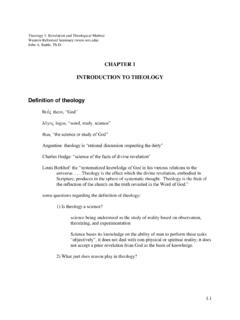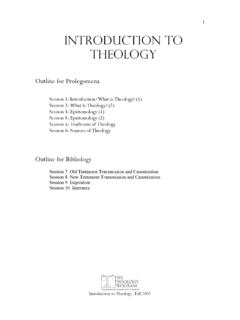Transcription of Pope John Paul II’s Theology of the Body
1 Freedom, truth, gift, communion, dignity, love, person,meaning: these are all themes which are continually foundthroughout the writings of Pope John Paul II. They werethere even before he became Pope. As Cardinal KarolWojtyla he was influential in the writing of severaldocuments from Vatican II, not the least of which wasGaudium et Spes the Pastoral Constitution on the Churchin the Modern World from which he never tires ofquoting in his many encyclicals and apostolic letters. Man is the only creature on earth which God willed foritself, [and he] cannot fully find himself except through asincere gift of himself. (Gaudium et Spes 24)We must first know the purpose of our existence and whatwe were created for if we are to live a fully meaningful John Paul II explores the purpose of our existence inhis Theology of the Body,which consists of 129 generalWednesday audiences delivered by him during the firstfive years of his to his election as pope, John Paul II wrote a book, L o v eand Responsibility.
2 In Love and Responsibility K a rol Wo j t y l ap resents the Catholic Church s teaching on love andsexuality in a way that makes sense to modern stresses the dignity of the person and shows howimportant it is to live our sexuality in a way which upholdsand affirms the other person. Indeed, the true lover willnever use another person or treat her as a means to an end. In his Theology of the BodyJohn Paul II digs deep into themeaning of being a human person based on Scripture. Asa person with a body and soul, made in the image andlikeness of God, we find the meaning of life throughfinding out what it means to image God and what ourbodies have to do with not only image God through the gift of free-will, butalso through being in communion with others.
3 To behuman means to be called to interpersonal communion. Why? Because God himself is a communion of persons inthe Trinity. He explains, Man became the image andlikeness of God not only through his own humanity, butalso through the communion of persons which man andwoman form right from the beginning. (TOB, Nov. 14, 1979) Man Cannot Live Without Love A communion of persons occurs when two people freelygive themselves to each other and accept one another inlove. In fact, true love consists precisely in this mutual we see in the Gospels, the main point of theChristian life is to love. John Paul II s other favorite quote from Gaudium et Spestells us that, reveals man to man himself andmakes his supreme calling clear.
4 What does Christ revealbut that, Greater love has no man than this, that a man laydown his life for his friends. ? (Jn. 15:13)It is Christ himself who reveals to us our basic vocation aspersons by giving himself to us in his death on the his Theology of the Body,John Paul II seeks topresent to us the Gospel message of love in a new, deep,and profound way. He knows that love is what all peopleseek. He goes so far as to say, Man cannot live withoutlove. He remains a being that is incomprehensible forhimself, his life is senseless, if love is not revealed to him, ifhe does not encounter love, if he does not experience loveHow important it is to live our sexuality ina way which upholds and affirms theother person!
5 Indeed, the true lover willnever use another person or treat her asa means to an John Paul II s Theology of the BodyThis publication 2003 Resurrection Box 21357 Cheyenne, WY82003-7026 For more information, please contact us at:Toll-free: 1-866-333-6392 groups meet regularly to discuss the Theology of theBody. Visit for information ona group near you or how to start one of your , Truth, Gift, Communion, Dignity, The Sincere Gift of Self Pope John Paul II sTheology of the Body Cover essay continued on page 11 The Theology of the Body What, Why and How?Through his Theology of the body, Pope John Paul II seeksto explain what the body means as a sign of the person andthe person s call to be a gift, and how it reveals the natureof God and His plan for mankind.
6 He demonstrates theg reat importance of the physical body and humansexuality, and battles the heresies which, valuing only thespiritual, would proclaim the body unimportant, evil, orboth. Through discussing the body in its creation andredemption, John Paul II simultaneously lays out the verymeaning of life and how we are to live it! He not only tellsus who man is, but how every person s vocation to love canbe lived out either through marriage or through celibacyfor the kingdom of God. The fact that Theology also considers the body should notastonish or surprise anyone who is aware of the mysteryand reality of the Incarnation. Theology is that sciencewhose subject is divinity.
7 Through the fact that the Word ofGod became flesh, the body entered Theology through themain door. The Incarnation and the redemption thatsprings from it became also the definitive source of thesacramentality of (TOB April 2, 1980) p. 88 To understand all that the redemption of the body impliesaccording to Paul s Letter to the Romans, an authentictheology of the body is necessary. We have tried toconstruct this Theology by referring first of all to the wordsof Christ. The constitutive elements of the Theology of thebody are contained in what Christ says: in recalling thebeginning, concerning the question about theindissolubility of marriage ( Mt.)
8 19:8); in what he saysabout concupiscence, referring to the human heart in hisSermon on the Mount (cf. Mt. 5:28); and also in what he saysin reference to the resurrection (cf. Mt. 22:30). Each one ofthese statements contains a rich content of ananthropological and ethical nature. Christ is speaking toman, and he is speaking about man: about man who is body and who has been created male and female in theimage and likeness of God. He is speaking about manwhose heart is subject to concupiscence, and finally, aboutman before whom the eschatological prospect of theresurrection of the body is opened. (TOB July 21, 1982) p. 300 Original Unity of Man andWomanImage of GodIn the first chapter of Genesis we are told that Adam andEve (and all of mankind) were created in the image andlikeness of God.
9 We are in the image of God not onlythrough the gift of our intellect and free will, through ourability to know and to choose, but also through our abilityto possess ourselves and then give ourselves to anotherperson, forming a communion of persons in love, sinceGod who is love is also a communion of persons in theTrinity. Man became the image and likeness of God not onlyt h rough his own humanity, but also through thecommunion of persons which man and woman form rightfrom the becomes the image of God not somuch in the moment of solitude as in the moment ofcommunion. Right from the beginning, he is not only animage in which the solitude of a person who rules theworld is reflected, but also, and essentially, an image of aninscrutable divine communion of persons.
10 (TOB Nov. 14,1979) p. 46 The human body bore in itself, in the mystery of creation,an unquestionable sign of the image of God. (TOB May 14,1980) p. 113 Original SolitudeMan experiences the original solitude in two ways: Firstin that he is alone as the only rational creature on earth. Heis aware of himself, of his body and its meaning. In his self-knowledge he knows that he is created by God, and istherefore not God. He realizes that he is not the same as theanimals either. With his self-knowledge he also has self-determination, by which he can choose between good andevil. He is the only one capable of tilling the earth, whichGod gave him to tend and rule. Secondly, he is alonewithout the woman, without another human person.



